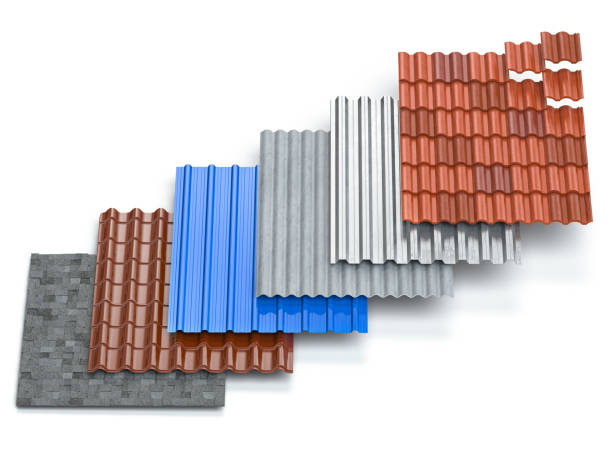What is The Best Roofing Materials?
by siteadmin

When choosing a roof for your home it is important that you choose materials which will protect it from weather hazards and last long enough. They should also offer value for the money invested. It can be difficult to choose the best roofing material from so many available options.
Asphalt
Asphalt shingles have been one of the most popular roof options in North America owing to their relatively low initial costs and ease of install. Asphalt shingles will last in most climates. Their lifespan, however, may not be as long.
Budget: 3-tabs shingles are the most affordable option. Architectural or dimensional roofing shingles can be more expensive. Malarkey and other high-end brands offer impressive warranties and durability.
Climate: Certain roofing shingles reflect the heat of the sun, helping to keep homes cool. Other shingles can withstand freezing temperature and high wind. Consult a roofing professional when choosing which material will work best for your house. They can help you understand costs associated with roof installation and maintenance over time.
Slate
Slate roofs offer homeowners a long-lasting roofing solution. Slate can outlast other roofing materials if installed correctly. This is because it resists water damage, fade damage and temperature fluctuations.
Natural slate gives homeowners a range of choices when it comes to choosing the right decor for their home. Its classic sophistication also adds great value.
Natural slate roofs can be highly resistant against mold, fading or other common problems. However, direct impact may cause it crack or shatter. This can result in homeowners spending thousands on repairs or replacing the roof. Synthetic slates are available in similar styles at lower prices.
Clay Tiles
Clay tiles can be used to improve the curb appeal of any home and add value. They act as natural insulation while also helping to reduce energy bills. This is done by improving airflow, thermal emittance (thermal emittance), solar reflectance and moisture content.
Earthen Clays are formed by molding and then fired until hardened, making the wall durable for any climate. The tiles come in many styles and can even be colored to match any architectural style.
The life expectancy of your tile roof is dependent on your maintenance habits and the environment. Clay tiles can be heavier and more difficult to install than shingles. Clay tiles of this type interlock on every side, so they don't need to be closed for eaves or freeze/thaw. Professional installation can also be recommended in areas that have frequent freeze/thaw. French tiles can be used as an alternative to interlocking tiles. They are also available in a variety of sizes and colors.
Rolled Roof
Roll roofing is made of different materials. It can be used for low-sloped or flat roofs. Roll roofing can be more affordable than other types of roof solutions. However, there are some drawbacks.
Plastics with a thinner composition may not be able withstand extreme conditions such as hail or wind. The lack of insulation in thinner plastics may require additional efforts to increase energy efficiency.
Smooth finish rolled rubber roofing is composed of organic cellulose felt saturated with asphalt for strength. It's a temporary roof during repairs or remodeling. It can also be used to cover small sheds, shops, garages or any other small building. However, this type of roofing is not attractive or durable enough to cover homes or other occupied structure.
Membrane Roofing
Membrane roofs combine components for weatherproofing, reinforcement, and surfacing all into one system. This provides maximum weatherproofing with low installation costs. They're often used on roofs that are flat or have a very low pitch, where traditional roofing materials like shingles or tiles might fail.
EPDM membrane (ethylene propylene diene terpolymer), which is black in colour, is a very durable rubber surface. It can last up 50 years and requires little maintenance. Due to its black colour, it tends absorbing heat more efficiently, increasing the cooling costs accordingly.
TPO was designed as an energy saving alternative to PVC roofs. Its white membranes reduce energy bills and costs by reflecting heat. TPO, similar to EPDM, comes in both fully adhered as well as ballasted forms. The adhesive qualities of TPO enable mechanical or chemical fastening for hot-air welding of insulation board or hot-air welding directly onto the membrane surface.
When choosing a roof for your home it is important that you choose materials which will protect it from weather hazards and last long enough. They should also offer value for the money invested. It can be difficult to choose the best roofing material from so many available options. Asphalt Asphalt shingles have been one…
Recent Posts
- Roofing Company Savannah Sheds Light on the Lifespan of Roofs: How Long Should a Roof Last?
- New Orleans Concreters Advocates for Stamped Concrete Driveways as the Ultimate Choice for Durability and Style
- New Orleans Concreters Advocates for Stamped Concrete Driveways as the Ultimate Choice for Durability and Style
- Gutter Installation Jacksonville FL: Revolutionizing Home Protection
- The Comprehensive Guide to Gutters in Jacksonville FL
